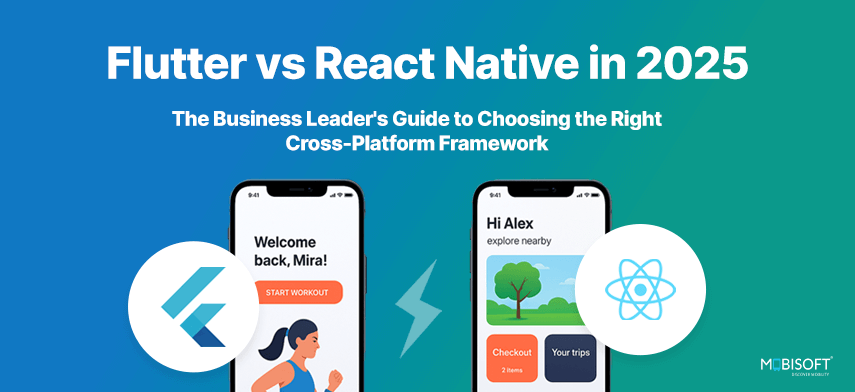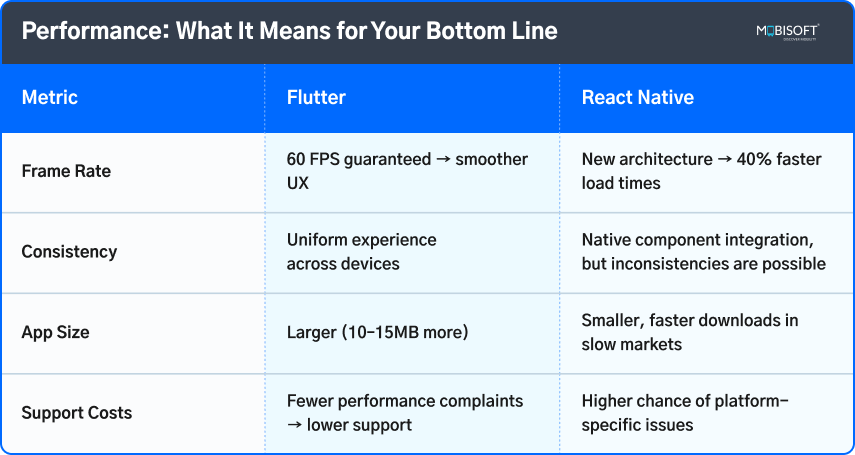Flutter vs React Native in 2025: The Business Leader’s Guide to Choosing the Right Cross-Platform Framework

The mobile app development decision you make today will impact your business for years. The debate over Flutter vs. React Native in 2025 remains one of the most contentious choices in cross-platform mobile development. Both frameworks maintain close competition in developer adoption, with strong growth and active communities. But for business leaders, the question goes beyond popularity; it’s about ROI, time-to-market, scalability, and long-term maintenance costs.
This guide provides the practical insights you need to make an informed decision that aligns with your business app development objectives.
The Current State of Affairs: Flutter vs React Native Market Position
The Business Impact of Market Leadership
Current Market Position (2024 Data):
- Flutter: 9.4% developer usage with 63.9% admiration score – strongest growth momentum
- React Native: 8.4% developer usage with 60% admiration score – established ecosystem
- Cross-Platform Adoption: 70% of developers favor multi-platform tools in 2024
- GitHub Popularity: Flutter leads with 160K stars vs React Native’s 114K
Cost Implications of Framework Choice:
- Flutter’s Growth: Leading in developer preference (Stack Overflow 2024 Survey) among learning developers
- React Native’s Stability: Strong JavaScript foundation means a larger talent pool (Stack Overflow 2024)
- Long-term Support: Both are backed by Google (Flutter) and Meta (React Native), ensuring sustained growth in cross-platform mobile app development.
What This Means for Your Budget:
- Flutter developers: Market rates vary by region.
- React Native developers: Generally competitive with JavaScript developers.
- Hidden Cost: Flutter requires Dart expertise; React Native leverages existing web developers
Performance: What It Means for Your Bottom Line

Business Impact: Both frameworks offer significant advantages – Flutter for consistency and performance, React Native for development speed, and JavaScript ecosystem leverage.
Looking to explore more about mobile-first strategies? Check our mobile app development company.

Architecture Deep Dive: Where They Differ Fundamentally
Flutter’s Canvas-Based Rendering
Flutter renders everything on its own canvas using the Skia graphics library. This means:
- Consistent UI across all platforms
- Complete control over every pixel
- No dependency on platform UI components
- Higher performance but larger app sizes
React Native’s Native Component Approach
React Native transforms JavaScript components into genuine native components:
- Authentic platform look and feel
- Leverages existing platform design languages
- Smaller initial bundle sizes
- Platform-specific UI inconsistencies are possible
Want to strengthen your Flutter knowledge? Explore Flutter state management with BLoC.
Read More: https://mobisoftinfotech.com/resources/blog/mobile/flutter-vs-react-native-2025-business-guide
- AI
- Vitamins
- Health
- Admin/office jobs
- News
- Art
- Causes
- Crafts
- Dance
- Drinks
- Film
- Fitness
- Food
- Spiele
- Gardening
- Health
- Startseite
- Literature
- Music
- Networking
- Andere
- Party
- Religion
- Shopping
- Sports
- Theater
- Wellness


